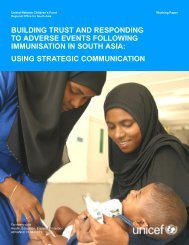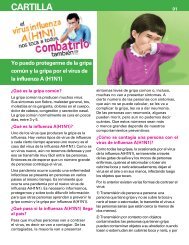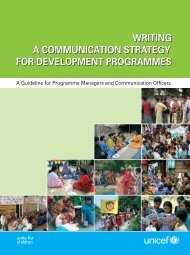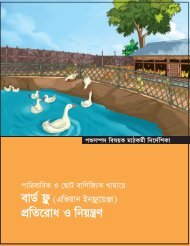FAO-OIE-WHO Joint Technical Consultation on Avian Influenza at ...
FAO-OIE-WHO Joint Technical Consultation on Avian Influenza at ...
FAO-OIE-WHO Joint Technical Consultation on Avian Influenza at ...
- No tags were found...
You also want an ePaper? Increase the reach of your titles
YUMPU automatically turns print PDFs into web optimized ePapers that Google loves.
<str<strong>on</strong>g>FAO</str<strong>on</strong>g>-<str<strong>on</strong>g>OIE</str<strong>on</strong>g>-<str<strong>on</strong>g>WHO</str<strong>on</strong>g> <str<strong>on</strong>g>Joint</str<strong>on</strong>g> <str<strong>on</strong>g>Technical</str<strong>on</strong>g> <str<strong>on</strong>g>C<strong>on</strong>sult<strong>at</strong>i<strong>on</strong></str<strong>on</strong>g> <strong>on</strong> <strong>Avian</strong> <strong>Influenza</strong> <strong>at</strong> the Human-Animal Interface• Implement<strong>at</strong>i<strong>on</strong> of government compens<strong>at</strong>i<strong>on</strong> promotingrapid disease reporting and transparency• Upgraded n<strong>at</strong>i<strong>on</strong>al labor<strong>at</strong>ory diagnostic capacity andinfrastructureChallenges:• Inadequ<strong>at</strong>e virological and epidemiological surveillancein domestic poultry including w<strong>at</strong>erfowl, and in wildbirds• Understanding the linkage between poultry outbreaksand disease in humans, including understanding occurrenceof human cases where no cases were reported inpoultry• Risks from extensive backyard, household, and rooftoppoultry producti<strong>on</strong>• Risks from LBMs• Large popul<strong>at</strong>i<strong>on</strong>s of poultry to vaccin<strong>at</strong>e and risks posedby unvaccin<strong>at</strong>ed poultry in LBMs and household flocks• Cultural practices such as cock fighting• Ineffective (or unfunded) compens<strong>at</strong>i<strong>on</strong> programs forculled poultry during outbreak c<strong>on</strong>trol• Ongoing tensi<strong>on</strong>s between levels of governments andam<strong>on</strong>g sectors5 Broadening the use of tools andsystems (Sessi<strong>on</strong> 5)During this sessi<strong>on</strong> speakers briefly discussed emerginginfectious diseases (EIDs) <strong>at</strong> the human–animal interface,tools and methods used to evalu<strong>at</strong>e emergence of otherzo<strong>on</strong>otic diseases, and the <str<strong>on</strong>g>OIE</str<strong>on</strong>g> ⁄ <str<strong>on</strong>g>FAO</str<strong>on</strong>g> ⁄ <str<strong>on</strong>g>WHO</str<strong>on</strong>g> Global EarlyWarning System for transboundary animal diseases(GLEWS). There was recogniti<strong>on</strong> th<strong>at</strong> some tools and systemswere developed for, or strengthened by, the H5N1 situ<strong>at</strong>i<strong>on</strong>over the past 10 years, but th<strong>at</strong> these systems havealso been used effectively to address many other zo<strong>on</strong>oticor emerging diseases.Presenters emphasized th<strong>at</strong> EIDs are the ‘‘new reality’’ asup to 34 new EIDs are expected worldwide by 2015, andnoted th<strong>at</strong> 61% of EIDs are zo<strong>on</strong>oses. Speakers reviewed thefactors influencing emergence including genetic, biological,physical, envir<strong>on</strong>mental, ecological, social, political, and ec<strong>on</strong>omicfactors, as well as the role of animal and public healthsystems. Changes in host–p<strong>at</strong>hogen ecology were c<strong>on</strong>sideredthe most important single driver for emergence. The c<strong>on</strong>vergenceof these human, animal, and envir<strong>on</strong>mental health factorsrequires working collabor<strong>at</strong>ively, in a multidisciplinaryway, and <strong>at</strong> local, n<strong>at</strong>i<strong>on</strong>al, and global levels to <strong>at</strong>tain optimalhealth of humans, animals, and the envir<strong>on</strong>ment. In discussi<strong>on</strong>,it became clear th<strong>at</strong> this c<strong>on</strong>cept was not new, howeverthe roles and str<strong>at</strong>egies of all the players globally are not fullyunderstood nor effectively integr<strong>at</strong>ed.‘‘Wicked problems’’ (those th<strong>at</strong> have no soluti<strong>on</strong> throughtraditi<strong>on</strong>al processes) were discussed in the c<strong>on</strong>text of EIDs,and it was noted th<strong>at</strong> managing these problems requireslinking together separ<strong>at</strong>e problem-solving activities into integr<strong>at</strong>edstr<strong>at</strong>egies and systems. For example, all countries havea stake in every<strong>on</strong>e else’s disease surveillance, however it isnot necessarily in a country’s best interest to share surveillanceinform<strong>at</strong>i<strong>on</strong> with their neighbors or the intern<strong>at</strong>i<strong>on</strong>alcommunity. Managing such dilemmas requires workingacross disciplines, professi<strong>on</strong>s, and animal and public healthcommunities and factoring in social, ec<strong>on</strong>omical, and politicalforces, as well as ensuring political will, prioritizingresearch to support evidence-based policies and decisi<strong>on</strong>s,adding value gained from avian influenza H5N1 experienceby applying it to other zo<strong>on</strong>oses, determining the potentialapplic<strong>at</strong>i<strong>on</strong> of ‘‘big science’’ (e.g., global technology and bioinform<strong>at</strong>ics)and cre<strong>at</strong>ing c<strong>on</strong>current planning scenarios ofimproving wh<strong>at</strong> exists and cre<strong>at</strong>ing wh<strong>at</strong> doesn’t.The animal and public health sectors have vast experiencein addressing EIDs, and recognize the importance of rapidresp<strong>on</strong>se, global collabor<strong>at</strong>i<strong>on</strong>, and multidisciplinary teams.In the past, these activities have c<strong>on</strong>sistently been d<strong>on</strong>e separ<strong>at</strong>ely,but now the c<strong>on</strong>tinuum between animal and humanp<strong>at</strong>hogens, the need for integr<strong>at</strong>ed (meaning linked not necessarilysingle) str<strong>at</strong>egies, and the need for improved animaland public health infrastructures is increasingly apparent.Health is now recognized as an outcome shaped by a broadrange of social, ec<strong>on</strong>omic, n<strong>at</strong>ural, ecological and politicalenvir<strong>on</strong>ments th<strong>at</strong> form an ever-changing dynamic. Thus,new ways of working together need to be identified th<strong>at</strong>reflect this reality. Our work <strong>on</strong> avian influenza H5N1 hasgiven us valuable experience in how to effectively do riskcommunic<strong>at</strong>i<strong>on</strong> and messaging, and how to evalu<strong>at</strong>e socialand cultural determinants of disease; however, we must build<strong>on</strong> these experiences and become even better as we appreci<strong>at</strong>ethe need to incorpor<strong>at</strong>e the social sciences into our str<strong>at</strong>egiesto c<strong>on</strong>fr<strong>on</strong>t new emerging zo<strong>on</strong>oses.Today’s technologies can help to better detect, manage,and c<strong>on</strong>tain the intern<strong>at</strong>i<strong>on</strong>al spread of EIDs. There havebeen gre<strong>at</strong> improvements in global tools and systems, suchas surveillance and forecasting of emerging diseases throughintersectoral (animal, human, and envir<strong>on</strong>ment) collabor<strong>at</strong>i<strong>on</strong>such as GLEWS, formal collabor<strong>at</strong>i<strong>on</strong> with wildlife diseaseexperts, support of EID vectorborne network, and<str<strong>on</strong>g>WHO</str<strong>on</strong>g> global outbreak alert and resp<strong>on</strong>se network(GOARN), global public health inform<strong>at</strong>i<strong>on</strong> network(GPHIN), and c<strong>on</strong>necti<strong>on</strong> of different labor<strong>at</strong>ory networks.Technology and successful collabor<strong>at</strong>i<strong>on</strong>s have allowed riskmapping, forecasting and early detecti<strong>on</strong> of EID events[e.g., Rift valley fever (RVF) and Ebola]. Working together<strong>on</strong> each of the steps from forecasting through resp<strong>on</strong>se <strong>at</strong>the country-level builds trust, and therefore facilit<strong>at</strong>es amore efficient and coordin<strong>at</strong>ed resp<strong>on</strong>se and improved preventi<strong>on</strong>and c<strong>on</strong>trol. It was noted th<strong>at</strong> standardiz<strong>at</strong>i<strong>on</strong> ofrisk analysis and forecasting needs to be addressed, includ-ª 2010 <str<strong>on</strong>g>FAO</str<strong>on</strong>g>, <str<strong>on</strong>g>OIE</str<strong>on</strong>g> and <str<strong>on</strong>g>WHO</str<strong>on</strong>g>, <strong>Influenza</strong> and Other Respir<strong>at</strong>ory Viruses, 4 (Suppl. 1), 1–29 13











